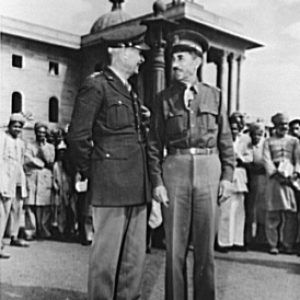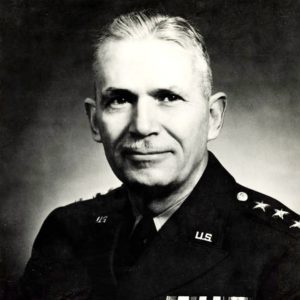calsfoundation@cals.org
Brehon Burke Somervell (1892–1955)
General Brehon Somervell was a major factor in the success of American military forces during World War II. He oversaw the construction of troop-training facilities and the supply of all American military forces. As construction division chief of the Army Quartermaster Corps, he was a major influence in the planning and construction of the Pentagon.
Brehon Burke Somervell was born on May 9, 1892, in Little Rock (Pulaski County), the only child of Dr. William Taylor Somervell and teacher Mary S. Burke. In 1906, his family moved to Washington DC. In 1910, Somervell received an appointment to West Point upon the recommendation of Representative Charles C. Reid of Arkansas and, in 1914, graduated sixth in a class of 107. Upon graduation, he was commissioned a second lieutenant in the U.S. Army Corps of Engineers.
World War I erupted while he was on a two-month European leave following graduation. He served as a volunteer military attaché at the U.S. Embassy in Paris, France, assisting U.S. citizens attempting to return home. After a month, he returned to Washington DC to an engineer battalion assignment. He was promoted to first lieutenant on February 18, 1915.
Somervell participated in the 1916 Punitive Expedition into Mexico. On May 15, 1917, he was promoted to captain, assisting in the organization of the Fifth Engineers, with whom he deployed to Europe in July 1917. For his service with the Fifth, he was awarded the Distinguished Service Medal. He served temporarily as assistant chief of staff to Colonel John Lee of the Eighty-ninth Division. After leading a reconnaissance patrol into enemy lines, he was awarded the Distinguished Service Cross. He remained with the Eighty-ninth as part of the Occupation Army in Germany until 1920. Before returning to the states, he married Anna Purcell, who was working with the Young Men’s Christian Association (YMCA); they had three daughters. On October 1, 1918, he was given the temporary rank of lieutenant colonel.
After returning to the United States, Somervell served with the Corps of Engineers in Washington DC, New York, Tennessee, and Florida. In 1923, he graduated in the top fifteen of his class from the General Staff College, and, in 1925, he attended the Army War College; both schools were reserved for the most promising young officers. During the Depression, he became the head of the Works Progress Administration (WPA) for the city of New York. LaGuardia Airport was one of his most notable directed projects. On August 1, 1935, he was fully promoted to the rank of lieutenant colonel.
Around the time of World War II, Somervell embarked upon some of the most significant projects of his career. In 1940, he was appointed as head of the Construction Division of the Quartermasters Department. In this position, Somervell was responsible for the development of the training bases needed to prepare U.S. troops for the war. On January 29, 1941, he was given the temporary rank of brigadier general. He immediately lobbied for the consolidation of the military high command in a central location. Due to his efforts, the Pentagon was constructed. For his service, an Oak Leaf Cluster was added to his Distinguished Service Medal.
Somervell pushed for the development of a comprehensive army supply program. On January 28, 1942, he was promoted to the temporary rank of major general as assistant chief of staff, War Department G4. As head of the Services of Supply (changed to Army Services Forces in 1943), he was in charge of organizing the supply of U.S. military forces on all fronts. He was soon promoted to lieutenant general for his work. Presidential advisor Bernard Baruch described Somervell as “one of the few Americans who really understands total war.”
Somervell’s wife died in 1942. He married Louise Hampton Wartmann in 1943.
Somervell retired from the military on April 30, 1946. In 1948, he was promoted to the permanent rank of four-star general on the retired list. Approximately a month before his retirement became official, he became president of Koppers Company, a producer of industrial machinery and industrial by-products based in Pittsburgh, Pennsylvania. Under Somervell’s direction, the company experienced a postwar boom.
Somervell’s postwar health was not good. In the early 1950s, he endured an appendectomy and a hernia operation. In September 1954, after suffering a heart attack, he returned to his home in Ocala, Florida, for a recovery period. By early 1955, he had decided not to return to Koppers. On February 13, 1955, Somervell, who once called himself “just a country boy from Arkansas,” suffered a fatal heart attack. He is buried in Virginia’s Arlington Cemetery. The USAV General Brehon B. Somervell, a Frank S. Besson–class U.S. Army Reserve support vessel, was named in his honor.
For additional information:
Black, Maxine, ed. Current Biography: Who’s News and Why 1942. New York: The H. W. Wilson Co., 1942.
“Gen. Somervell Dead in Florida.” New York Times. February 14, 1955, p. 19.
Ohl, John Kennedy. Supplying the Troops: General Somervell and American Logistics in WWII. DeKalb: Northern Illinois University Press, 1994.
“Retired Chief of Army Supply Dies in Florida.” Arkansas Gazette. February 14, 1955, pp. 1–2.
“Somervell Dies after Heart Attack.” Arkansas Democrat. February 14, 1955, p. 6.
Mike Polston
CALS Encyclopedia of Arkansas








Comments
No comments on this entry yet.